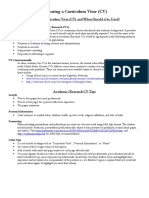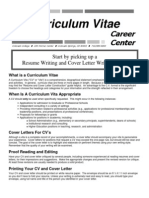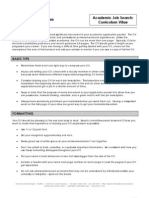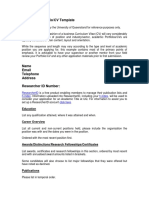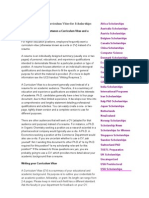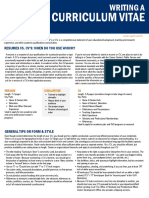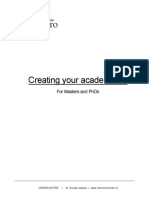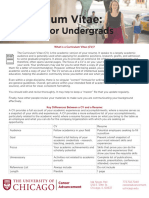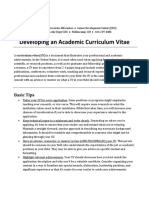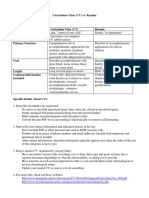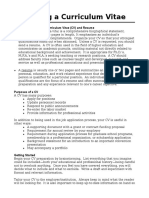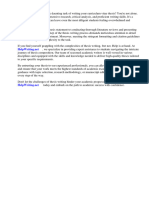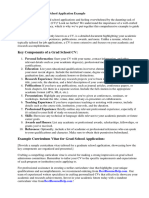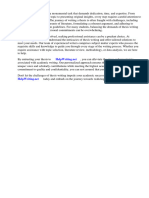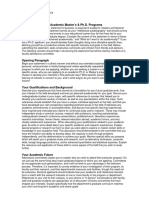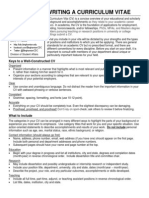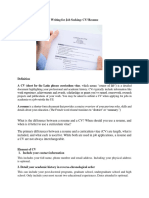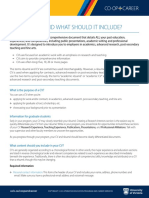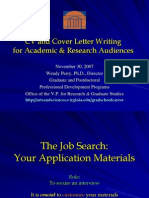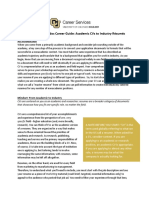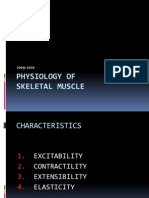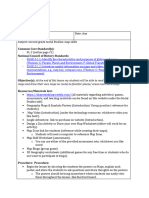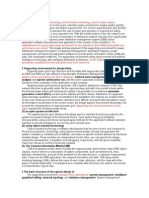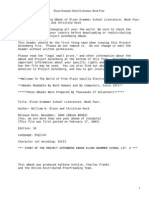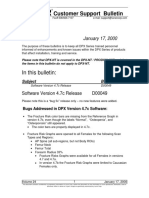Writing A Curriculum Vitae
Writing A Curriculum Vitae
Uploaded by
Sherwan R ShalCopyright:
Available Formats
Writing A Curriculum Vitae
Writing A Curriculum Vitae
Uploaded by
Sherwan R ShalOriginal Description:
Original Title
Copyright
Available Formats
Share this document
Did you find this document useful?
Is this content inappropriate?
Copyright:
Available Formats
Writing A Curriculum Vitae
Writing A Curriculum Vitae
Uploaded by
Sherwan R ShalCopyright:
Available Formats
Writing a
Curriculum Vitae
A curriculum vitae (Latin for “the course of one’s life”), or CV, is a comprehensive statement of
your educational background, teaching and research experience, and other academic qualifications
and activities. In academic circles, the CV is the foundation of any application for employment,
funding, awards, fellowships, or grants. A CV can serve other purposes as well, such as providing
the basis for an annual review by your employer or for introductions at conference presentations.
Many search committees will look at the CVs of job candidates before anything else in screening
applications. It is therefore extremely important that your CV effectively communicate the range
and scope of your qualifications while highlighting your particular teaching and research strengths.
Because CV styles and norms vary from one discipline to another, you should have your CV
reviewed by faculty in your department/field before sending it out! The Graduate School of Arts
and Sciences (GSAS) career counselor also provides critiquing services.
In contrast, a resume is not comprehensive. It is a snapshot (usually one to two pages in length) of
one’s qualifications intended to demonstrate fitness for a particular position or type of work. A
resume focuses attention on an individual’s strongest selected qualifications—not a full history of
them—and develops them to fit a specific or general purpose.
Unlike a resume, your CV will lengthen as you establish yourself professionally. A graduate
student typically has a two- to four-page document that grows as s/he progresses along the career
path. In creating your CV, you should present a trajectory of your life as a scholar, teacher, and
researcher from the time you began your academic career. All information on your CV should be
arranged in reverse chronological order, listing the most recent accomplishment first in each
section.
Like a resume, your CV should be tailored to particular purposes to highlight your strengths as
they apply. Doing so is both wise marketing and common sense. It shows your readers that you
think like they do and speeds their effort in evaluating your candidacy. The easier it is for them to
screen you “in,” the better your chances of making the cut. Driving readers to search for
information can frustrate them and decrease your odds. For example, in seeking employment at
academic institutions whose missions and objectives may differ, you should rethink the
presentation and arrangement of the information on your CV for each audience. When applying
to research institutions, it is wise to list your research, publications, presentations, and awards
prominently at the beginning. List your teaching experience first when applying to small liberal
University Career Services www.career.virginia.edu
Bryant Hall at Scott Stadium (434) 924-8900
1/3/2007 Page 1 of 6
arts schools or community colleges, and showcase any community or academic service on your
record.
CVs are also used in some non-academic circles, particularly those with strong research
components. If you are uncertain whether to use a CV or a resume, ask yourself, “Am I sending
this document to other PhDs?” “Is my PhD required for this position?” “Is my scholarship
relevant?” If yes, you should probably use a CV, which provides more detail about your academic
background than a typical resume.
Elements of the CV
Good organization and an effective use of section headings guide your audience in assessing your
qualifications. Sub-headings in lengthy sections can further facilitate this process. Below are
commonly used section headings with descriptions:
Identification (as this section opens your CV, omit the heading)
Include your name (set apart prominently at the top of the first page, using boldface,
capitalization, a larger font size, etc. at your discretion), address, complete telephone number/s,
and e-mail address. Some people include both personal and department addresses to emphasize
their current academic affiliation.
*Citizenship/Date and Place of Birth: In some fields this information is customarily included,
most frequently for funding considerations (e.g. for a grant-funded postdoctoral position). In
other fields it would be viewed as inappropriate. Follow the norm in your field.
Education
List all institutions, degrees, and graduation dates in reverse chronological order. If you attended
an institution but did not earn a degree, you do not need to list it on your CV unless the training
you received was vital to your career – language courses taken abroad, for instance. Some
postdoctoral researchers include their postdoctoral training here, other include it under their
research section; follow the norm in your field.
Dissertation/Dissertation Abstract
You may list the title of your dissertation beneath the information on your doctoral degree, as well
as the name of your chair/advisor and/or committee members. Some fields require a longer
description (about a paragraph) of the dissertation on your CV, generally under a separate section
entitled “Dissertation Abstract,” while other fields expect dissertation research to be listed under
“Research Experience.” Follow the norm in your field. If an abstract is not required, you may elect
to include a very brief description after the title – two to three sentences at most.
Awards, Fellowships, Honors, Grants
List all relevant academic distinctions, teaching awards, fellowships, honors, or grants your have
received since you entered graduate school in reverse chronological order. Include the name of the
department and institution bestowing the honor. Include undergraduate honors and fellowships if
University Career Services www.career.virginia.edu
Bryant Hall at Scott Stadium (434) 924-8900
1/3/2007 Page 2 of 6
they are relevant to your field or indicate exceptional academic achievement (e.g., summa cum
laude, Phi Beta Kappa, etc.).
Publications, Creative Work
Include bibliographic citations of articles, research reports, and book reviews that you have
published. If applicable to your field, poems, musical recitals, or art exhibits may be included in
this section. Depending upon your discipline, as you gain experience, you will further separate
these items into different categories, such as “book review,” “articles in refereed journals,” books,”
etc. Use the form of citation appropriate to your field. In order to list something as “forthcoming”
in this section, you should have a reasonably firm sense of when the publication will appear in
print, unless otherwise directed by your advisor.
Presentations/Meeting Abstracts
List all papers/talks you have given, along with the names, dates, and locations of the conferences
or meetings where you presented that work. If you have numerous publications, you may choose
to list only invited talks or selected abstracts. If you presented your work at a University of
Virginia symposium or workshop, you may also list the talk here if it was a substantial piece of
work or something directly relevant to your research agenda.
Work Submitted, Work in Progress
In some fields, it is fairly standard for scholars to add sections entitled “Work Submitted: and
“Work in Progress” to their CVs. Often these can be listed under a subheading in the publications
section. If you have an article or book under review at a refereed journal or academic press, you
should list it under the category “Work Submitted for Publication.” In this way, you can inform
employers that you have enough confidence in your work to submit it for publication. If you are an
experienced candidate, or want to change jobs, you will want to indicate the potential of
publication on new projects by reporting your progress in a section entitled “Work in Progress.”
Research Experience
Most often used in some of the natural and social sciences, this category can include dissertation
and possibly undergraduate and internship research. Typically, you describe your project(s)
(including any techniques you mastered) and list the affiliated lab and/or professor.
Teaching Experience
Include all full-time, part-time, and adjunct teaching experience. For each position, list your title,
the dates of employment (or semester and year), and the name (not the mnemonic) or each course
your taught. Include a brief description of your responsibilities and the size of the course. Since job
titles vary from one university to another, you need to tell the employer something about your level
of involvement in the course design, preparation of materials, weekly instruction, and grading.
Research Interests, Teaching Interests/Competencies (separate sections)
In some fields it is effective to list your current research and/or teaching interests. When listing
your teaching interests or competencies, be sure to list general as well as specialized categories so
University Career Services www.career.virginia.edu
Bryant Hall at Scott Stadium (434) 924-8900
1/3/2007 Page 3 of 6
that employers know you are capable and willing to teach the undergraduate and general education
requirements offered in their departments. This is especially important for junior scholars who
may not have yet had the opportunity to teach all areas of their expertise.
Professional Training/Related Work Experience
List any special professional training you received in your department or through a professional
organization in this section. Such training may include special courses on pedagogy or teaching
techniques, professional seminars offered by a professional organization, or technical or computer
training completed in addition to your regular coursework. If you have non-academic work
experience that is relevant to your application, list and describe such experience here.
Languages
List your language skills, as well as some indication of your level of expertise (e.g., “Reading
knowledge of French and German” or “Fluent in Hindi; working knowledge of Swahili”).
Professional Affiliations and Service
List the major professional organizations to which you belong or with which you are affiliated. If
you have served actively in one or more of these organizations, you may wish to indicate the level
or your involvement as well.
Academic Service, Community Outreach
If you have served on any committees (such as graduate advisory or search committees in your
department or any appointed or elected position in the university), list the experience here. You
may also note in this category any talks you gave or meetings you arranged in your department
about professional issues in your field. Demonstrating service will tell employers that you are a
good citizen in your current department and institution. If you have volunteered your time in
other ways related to your discipline within the community at large (e.g., judging a science fair,
school and museum outreach, etc.), you can list such activities here as well.
References
Either at the end of your CV or in a separate “References” document, list the names, titles, and
academic affiliations of your references. List your references in order of importance (e.g. your
dissertation director/advisor first, followed by other members of your committee or other advisors
who know your work well). It is customary to list the mailing and e-mail addresses and telephone
numbers of your references. Follow the standard practice in your field.
General Tips on Form and Style
Even though content determines the length of your CV, you should aim for a tightly constructed,
succinct and efficient presentation of your credentials. There is no excuse for typographical error
in your CV. Proofread and ask others to proofread for you. Careless errors send a very bad
message. Begin your CV well before you need to submit it to allow time for critiques and
proofreading.
University Career Services www.career.virginia.edu
Bryant Hall at Scott Stadium (434) 924-8900
1/3/2007 Page 4 of 6
It is also exceeding important to be clear and consistent both in form and content. Use
unambiguous, concise descriptive language that facilitates speedy processing of critical
information. Avoid overly dense text with little white space separating entries. Create an
organizational hierarchy and apply it consistently throughout your CV.
• The title heading “Curriculum Vitae” is commonly used but optional.
• Each page after the first should bear your name and the page number in a header or footer.
Because maintaining a CV is iterative, you should get in the practice of updating it at least
every six months to a year. Many scholars include a “revised” date in a footer on the first
page.
• Use an 11- or 12-point font size with 1”- to 1 ½”-inch margins.
• Use action verbs, measured descriptions, parallel grammar, no first-person pronouns, and
little punctuation.
• Be careful not to pluralize section headings that cover one entry only.
• Keep dates to the right as opposed to listing them first in your sections. The reader’s eye
naturally gravitates to the left—you want your biggest selling points there (e.g. your
pedigree/school, your job title, etc.).
• Use boldface, italics, and spacing to highlight information, but be consistent and sparing in
your use. Overuse distracts readers and defeats your purpose.
• Avoid graphics, shading, and underlining; if you use lines, put at least ¼” inch of white
space around them.
• References to electronic materials/web links: Feel free to cite electronic references to
articles, portfolios, courses, etc., particularly to show your technical prowess if you created
the site. Personal web pages should be referenced only if all material presented is
professional. Irrelevant text (e.g. vacation photos, personal narratives, etc.) may turn off
some members of your audience.
• All CVs should be laser-printed in black ink on white or light-colored, 8 ½” x 11” bond
paper (look for “resume paper” at the U.Va. Bookstore).
Note: It has become more common to see headshot photographs on CVs, particularly in the
natural sciences. Think about what information this text communicates and be aware that some
search committees may cover up the photo in adherence to anti-discriminatory policies.
Recommended Resources
The Chronicle of Higher Education “Careers” web page at www.chronicle.com/jobs
See especially the CV Doctor in the “Tools & Resources” section.
The Academic Job Search Handbook (Mary Morris Heiberger & Julia Miller Vick, 2001)
The Curriculum Vitae Handbook: Using Your CV to Present and Promote Your Academic Career
(Gerald Roe & Rebecca J. Anthony, 1998)
Job Search in Academe: Strategic Rhetorics for Faculty Job Search Candidates (Dawn M. Formo &
Cheryl Reed, 1999)
University Career Services www.career.virginia.edu
Bryant Hall at Scott Stadium (434) 924-8900
1/3/2007 Page 5 of 6
Cracking the Academia Nut: A Guide to Preparing for Your Academic Career (Margaret Newhouse,
1997)
To Boldly Go: A Practical Career Guide for Scientists (Peter Fiske, 1996)
University Career Services www.career.virginia.edu
Bryant Hall at Scott Stadium (434) 924-8900
1/3/2007 Page 6 of 6
You might also like
- Academic Careers Curriculum Vitae TipsDocument18 pagesAcademic Careers Curriculum Vitae TipsYosafat Novianto Ade PutraNo ratings yet
- TheCurriculumVitae (CV) AndLetttersofApplicationDocument18 pagesTheCurriculumVitae (CV) AndLetttersofApplicationMarlo CardinezNo ratings yet
- Impact of Indian Drama Serial in Bangladeshi SocietyDocument20 pagesImpact of Indian Drama Serial in Bangladeshi SocietyJakir Hossain RajuNo ratings yet
- Consumption of OTT Media Streaming in COVID-19 Lockdown: Insights From PLS AnalysisDocument11 pagesConsumption of OTT Media Streaming in COVID-19 Lockdown: Insights From PLS AnalysisKhadijaNo ratings yet
- Dictionary of Information and Library ManagementDocument257 pagesDictionary of Information and Library ManagementTalento Humano100% (1)
- Research Method For ManagerDocument68 pagesResearch Method For ManagerNoman Ul Haq SiddiquiNo ratings yet
- Vita and LetterDocument20 pagesVita and LetterreadalotbutnowisdomyetNo ratings yet
- Canada Study Visa - Academic CV For Graduate StudiesDocument29 pagesCanada Study Visa - Academic CV For Graduate StudiesOluwadamilola Shitta-bey100% (1)
- Preparing CV Academic Research TipsDocument2 pagesPreparing CV Academic Research TipsbinsarNo ratings yet
- Cvs & Resumes For Graduate StudentsDocument7 pagesCvs & Resumes For Graduate StudentsAndreeaAlexandraAntonNo ratings yet
- CV Guide June 2016Document5 pagesCV Guide June 2016Luis VelazquezNo ratings yet
- Cvs and ResumesDocument7 pagesCvs and ResumesNib1992No ratings yet
- Curriculum VitaeDocument2 pagesCurriculum Vitaehussainhussain420100% (1)
- Teaching Position LetterDocument28 pagesTeaching Position Letterprofemina5025No ratings yet
- Basic Tips: Academic Job Search: Curriculum VitaeDocument18 pagesBasic Tips: Academic Job Search: Curriculum Vitaemohmoh8375No ratings yet
- Academic Portfolio/CV Template: EducationDocument3 pagesAcademic Portfolio/CV Template: Educationorang gilaNo ratings yet
- Tips On Writing A CVDocument6 pagesTips On Writing A CVEmeka IdamNo ratings yet
- Writing A CVDocument2 pagesWriting A CVNoe GNo ratings yet
- CV Guide U of Toronto PDFDocument29 pagesCV Guide U of Toronto PDFRon DSilvaNo ratings yet
- Academic CV TemplateDocument3 pagesAcademic CV TemplateAbhinav BansalNo ratings yet
- Curriculum Vitae CV WorksheetDocument2 pagesCurriculum Vitae CV WorksheetHubba ShyamalNo ratings yet
- Making A CVDocument12 pagesMaking A CVZain UlabideenNo ratings yet
- W6 Curriculum Vitae-Guide For UndergraduatesDocument6 pagesW6 Curriculum Vitae-Guide For Undergraduatesasc.delenajeseltonNo ratings yet
- CV Guide For PHD and Postdoctoral ResearchersDocument27 pagesCV Guide For PHD and Postdoctoral ResearchersRobinsonNo ratings yet
- Developing An Academic Curriculum Vitae: Basic TipsDocument12 pagesDeveloping An Academic Curriculum Vitae: Basic TipsVictor VinesNo ratings yet
- ACPHS Resume and CV Guide (May 2017)Document20 pagesACPHS Resume and CV Guide (May 2017)GregNo ratings yet
- Making A CVDocument12 pagesMaking A CVAnonymous shUWODvoNo ratings yet
- CV Template: Academic Careers: Revised June 2016 1Document4 pagesCV Template: Academic Careers: Revised June 2016 1rena yunitaNo ratings yet
- Writing A Curriculum VitaeDocument6 pagesWriting A Curriculum Vitaekarthik challaNo ratings yet
- Writing A CVDocument2 pagesWriting A CVRomyna Faith Grace VillanuzNo ratings yet
- Curriculum Vitae Thesis TitleDocument4 pagesCurriculum Vitae Thesis Titlesandraarvesethsaltlakecity100% (3)
- Academic CV TemplateDocument4 pagesAcademic CV Templatemail2rabindra2712No ratings yet
- Curriculum Vitae Grad School Application ExampleDocument7 pagesCurriculum Vitae Grad School Application Examplebcr7r579100% (1)
- Preparing Statement of IntentDocument2 pagesPreparing Statement of IntentHala Hashim Merghani100% (1)
- CV TipsDocument2 pagesCV Tipsjackson1212No ratings yet
- Curriculum Vitae TemplateDocument5 pagesCurriculum Vitae TemplateBob MilisNo ratings yet
- Curriculum Vitae Writing TipsDocument9 pagesCurriculum Vitae Writing TipsNeethu BilalNo ratings yet
- CV Writing TipsDocument5 pagesCV Writing Tipscsefaruk5810No ratings yet
- Creating An Effective CV For The Academic Job Search: Presented by The Career Development Center 12-170Document25 pagesCreating An Effective CV For The Academic Job Search: Presented by The Career Development Center 12-170books_ukNo ratings yet
- Resume Honors ThesisDocument5 pagesResume Honors Thesisafknjdsta100% (2)
- Statement of IntentDocument2 pagesStatement of Intentseviram441No ratings yet
- Curriculum Vitae For Thesis FormatDocument6 pagesCurriculum Vitae For Thesis Formatfjcsp27e100% (2)
- How To Write An Academic CV: Careers ServiceDocument2 pagesHow To Write An Academic CV: Careers Serviceseptian_bbyNo ratings yet
- Writing A Curriculum Vitae: Keys To A Well-Constructed CVDocument2 pagesWriting A Curriculum Vitae: Keys To A Well-Constructed CVBalakrushna SahuNo ratings yet
- Handout CVDocument3 pagesHandout CVMaretha AnggreaniNo ratings yet
- CV Course PDFDocument10 pagesCV Course PDFMariem Liouéne KarouiNo ratings yet
- The Curriculum VitaeDocument2 pagesThe Curriculum VitaeNoe GNo ratings yet
- SOP University Specified GuidelinesDocument4 pagesSOP University Specified GuidelinesVNo ratings yet
- What Is A CV and What Should It Include?: Information SheetDocument3 pagesWhat Is A CV and What Should It Include?: Information SheetOshada GamageNo ratings yet
- CV and Cover Letter Writing For Academic & Research AudiencesDocument73 pagesCV and Cover Letter Writing For Academic & Research AudiencessuryasivNo ratings yet
- CV Dissertation DistinctionDocument6 pagesCV Dissertation DistinctionBuyingPapersOnlineSingapore100% (1)
- Academic CV - RequirementsDocument2 pagesAcademic CV - Requirementsinkon24No ratings yet
- GradschoolDocument2 pagesGradschoolms246singhNo ratings yet
- CV WritingDocument2 pagesCV Writingsalman majeedNo ratings yet
- CV and ResumeDocument2 pagesCV and ResumeDeepa DiddiNo ratings yet
- Tourism Correspondence S9Document23 pagesTourism Correspondence S9she.died6661380No ratings yet
- CV Writing Guide 130902104011 Phpapp02Document8 pagesCV Writing Guide 130902104011 Phpapp02Versoza NelNo ratings yet
- Putting Dissertation On ResumeDocument6 pagesPutting Dissertation On ResumeBuyWritingPaperSingapore100% (1)
- Grad Student and Postdoc Career Guide: Academic Cvs To Industry RésumésDocument9 pagesGrad Student and Postdoc Career Guide: Academic Cvs To Industry RésumésDuyen NguyenNo ratings yet
- Curriculum Vitae Sample For ThesisDocument4 pagesCurriculum Vitae Sample For Thesiskimberlythomasarlington100% (3)
- Democracy or RepubicDocument8 pagesDemocracy or RepubicSherwan R ShalNo ratings yet
- Which Witch Is WhichDocument48 pagesWhich Witch Is WhichSherwan R ShalNo ratings yet
- Peripheral ANS Complete A To ZDocument65 pagesPeripheral ANS Complete A To ZSherwan R ShalNo ratings yet
- Listening HabitDocument32 pagesListening HabitSherwan R Shal100% (1)
- Physiology of Dua"A: Dr. Sherwan Rahman Sulaiman MD, MSC, PHD (Physiology)Document17 pagesPhysiology of Dua"A: Dr. Sherwan Rahman Sulaiman MD, MSC, PHD (Physiology)Sherwan R Shal100% (1)
- N A H I C: SuicideDocument4 pagesN A H I C: SuicideSherwan R ShalNo ratings yet
- Physiology of The Central Nervous SystemDocument43 pagesPhysiology of The Central Nervous SystemSherwan R Shal100% (1)
- Leadership Tips For WomanDocument20 pagesLeadership Tips For WomanSherwan R ShalNo ratings yet
- Halal and Haram Fact SheetDocument3 pagesHalal and Haram Fact SheetSherwan R ShalNo ratings yet
- Physiology of Skeletal MuscleDocument29 pagesPhysiology of Skeletal MuscleSherwan R ShalNo ratings yet
- Using SCRIBD in ClassroomDocument2 pagesUsing SCRIBD in ClassroomSherwan R ShalNo ratings yet
- The Chrismon Christmas Tree History Definition PurposeDocument4 pagesThe Chrismon Christmas Tree History Definition PurposeSherwan R ShalNo ratings yet
- Sexual Function Across Life Cycle in WomenDocument33 pagesSexual Function Across Life Cycle in WomenSherwan R ShalNo ratings yet
- Endocrine Physiology / Part OneDocument46 pagesEndocrine Physiology / Part OneSherwan R Shal100% (1)
- Christmas Quiz FrenchDocument85 pagesChristmas Quiz FrenchSherwan R ShalNo ratings yet
- Congestive Heart Failure, Pulmonary Edema, and CPAPDocument35 pagesCongestive Heart Failure, Pulmonary Edema, and CPAPSherwan R Shal100% (1)
- CV Writing TipsDocument6 pagesCV Writing TipsSherwan R Shal100% (15)
- Freud and FreudianDocument20 pagesFreud and FreudianSherwan R ShalNo ratings yet
- 95 Reading ResponsesDocument10 pages95 Reading ResponsesKate BarrowsNo ratings yet
- TeamViewer API DocumentationDocument40 pagesTeamViewer API DocumentationjonasoutlawNo ratings yet
- Voy A Apagar La Luz LyricDocument2 pagesVoy A Apagar La Luz LyricNyazzzNo ratings yet
- Đề Thi Đề Xuất Phú Riềng 18-19Document7 pagesĐề Thi Đề Xuất Phú Riềng 18-19Nguyễn Thu GiangNo ratings yet
- ЛЕКЦ ТЕОРГРАМ Для СтудентовDocument30 pagesЛЕКЦ ТЕОРГРАМ Для СтудентовNilufarxon TeshaboyevaNo ratings yet
- SR2e UppInt U2TestDocument3 pagesSR2e UppInt U2TestKhaing khant AungNo ratings yet
- Analytical Reading PDFDocument2 pagesAnalytical Reading PDFJeffrey Fernandez VelascoNo ratings yet
- Social Studies Lesson PlanDocument4 pagesSocial Studies Lesson Planapi-700564441No ratings yet
- 10 - Chapter 2 PDFDocument57 pages10 - Chapter 2 PDFRollo TomasiNo ratings yet
- Graphical Editing, Network Topology, and Database Management. System ManagementDocument3 pagesGraphical Editing, Network Topology, and Database Management. System ManagementМирко ГрбићNo ratings yet
- Val Integ 1 NazarenoDocument12 pagesVal Integ 1 Nazarenoapi-651394813No ratings yet
- Tập Bài Giảng - Kỹ Năng Tổng Hợp Tiếng Anh 1Document255 pagesTập Bài Giảng - Kỹ Năng Tổng Hợp Tiếng Anh 1Yen TranNo ratings yet
- In Defence of Polysystem TheoryDocument38 pagesIn Defence of Polysystem Theoryehsaan_alipour100% (4)
- Banking: SBI PO: PreliminaryDocument6 pagesBanking: SBI PO: PreliminaryVutla ChowdaryNo ratings yet
- XII - CS QuestionsDocument10 pagesXII - CS QuestionsTHOORIGAI KOLANGALNo ratings yet
- Employee File Management 4.0.1 - InstallationDocument26 pagesEmployee File Management 4.0.1 - InstallationtatarajNo ratings yet
- 6-70-122IT (1) RI Witness Database & Software Installation GuideDocument12 pages6-70-122IT (1) RI Witness Database & Software Installation Guidebmesadir14201No ratings yet
- Elson Grammar School Literature v4 by Elson, William H.Document349 pagesElson Grammar School Literature v4 by Elson, William H.Gutenberg.orgNo ratings yet
- HerbariumDocument11 pagesHerbariumapi-377900948No ratings yet
- LS M100 Easy Start GuideDocument14 pagesLS M100 Easy Start GuideKaan CanNo ratings yet
- GP - Pro EX Quick Start GuidesDocument21 pagesGP - Pro EX Quick Start GuidesAnonymous V9fdC6No ratings yet
- Hsu Myat Htet (S-16860) CV FormDocument3 pagesHsu Myat Htet (S-16860) CV FormHsu Myat HtetNo ratings yet
- Jenkin Interview Questions For Beginners:: 1. Describe About Some Characteristics of JenkinsDocument11 pagesJenkin Interview Questions For Beginners:: 1. Describe About Some Characteristics of Jenkinspavan kumarNo ratings yet
- The Interactions of The Chola Empire in The Chao Phraya DeltaDocument7 pagesThe Interactions of The Chola Empire in The Chao Phraya Deltamadhanraj91No ratings yet
- OOP - C++ Programming Basics-1Document78 pagesOOP - C++ Programming Basics-1Sourin SarkarNo ratings yet
- G12 Physical Education and Health (Fundamental Position of Arms and Feet)Document2 pagesG12 Physical Education and Health (Fundamental Position of Arms and Feet)MAYSIE ILAGANNo ratings yet
- Cross Cultural Communication Assignment TopicsDocument5 pagesCross Cultural Communication Assignment TopicsTuấn (1963) Nguyễn VănNo ratings yet
- SCHOOL DIARY 2021-2022 List of Holidays and EventsDocument8 pagesSCHOOL DIARY 2021-2022 List of Holidays and EventszkhksfhiNo ratings yet
- Qualities of A Good Reading ADocument16 pagesQualities of A Good Reading AagnesandalayNo ratings yet
- DPX VOl 24 4.7cDocument2 pagesDPX VOl 24 4.7cCarlos MoraNo ratings yet








